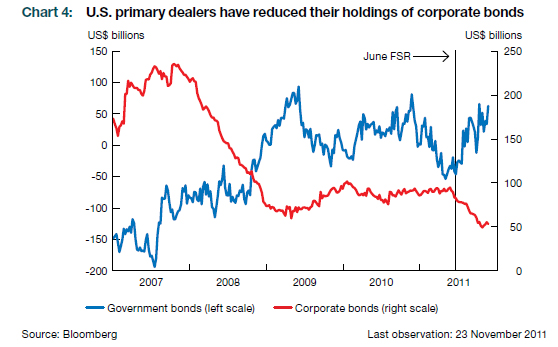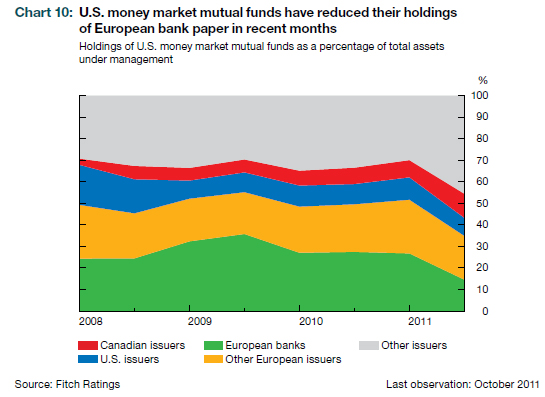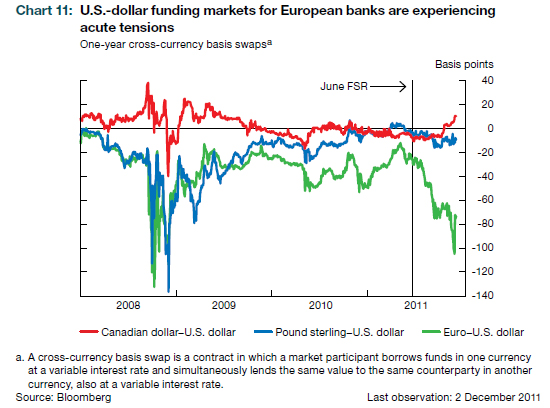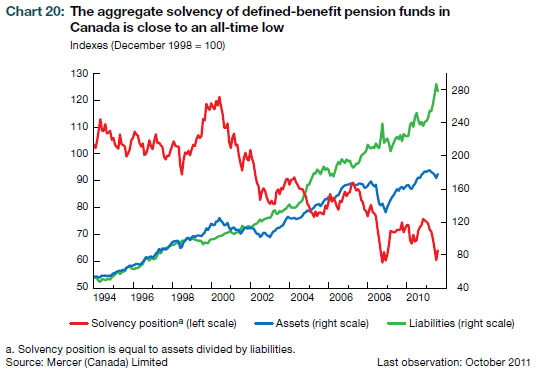The European governments need the banks, because the banks buy their debt. Guess who the banks depend on?
European banks turning to their governments to raise required capital could trigger a downward spiral of declining sovereign-debt prices and further losses for the lenders.
The European Banking Authority ordered the region’s banks on Dec. 8 to raise 115 billion euros ($154 billion) by June. Faced with dwindling profits and unable to tap capital markets to sell new shares, firms may be forced to seek government help. About 70 percent of the capital requirement falls on lenders in Spain, Greece, Italy and Portugal, countries struggling to convince the world they can pay their debts.
“If the Southern governments put money in their banks, their sovereign debt will go up, exacerbating their problems,” said Karel Lannoo, chief executive officer of the Centre for European Policy Studies in Brussels. “Then the banks’ losses will rise because they hold the government debt. That’s a vicious cycle. It’s hard to know which one to stabilize first, the sovereign bonds or the banks.”
European leaders unveiled a blueprint after meetings on Dec. 8 and 9 for a closer fiscal accord to save the euro, adding 200 billion euros to their bailout fund and tightening rules to curb future debts. They also agreed to start a 500 billion-euro rescue fund next year.
The agreement offered few new measures and doesn’t diminish the risk of credit-ranking revisions, Moody’s said in its Weekly Credit Outlook. “In the absence of any decisive policy initiatives that stabilize credit-market conditions effectively, our intention as announced in November is to revisit the level and dispersion of ratings during the first quarter of 2012,” the company said.
The company won’t be able to publish the earnings within the 30-day period stated on Nov. 15, Hong Kong- and Mississauga, Ontario-based Sino-Forest said today in a statement. There’s no assurance if or when the results will be released, it said. Sino-Forest also said a report by an independent committee into the fraud allegations now won’t be issued until 2012, instead of the year-end as previously stated.
Sino-Forest said it decided it won’t make a $9.78 million interest payment on its 2016 convertible notes that’s due Dec. 15. The company said it retained Houlihan Lokey and Bennett Jones LLP as its financial and legal advisers to assist in the evaluation of its options.
“In these circumstances, the board has determined that it must consider all strategic options available,” the company said in the statement. “The company may consider obtaining other sources of capital, including through the recapitalization of the company or the sale of some or all of its business.”
A lot of the fuss could be – could! – simply hysteria. That’s just people talking. But not being able to produce financials, another delay in the special committee report and skipping an interest payment … that’s real.
The Republicans are going to love this:
China may use tax cuts to shore up expansion in the second-largest economy next year as export growth weakens and the threat of bad loans from stimulus spending narrows the government’s options.
Another thing that’s real is Sun Life retreating from the US:
Sun Life Financial Inc. (SLF), Canada’s third-largest insurer, plans to stop selling variable annuities and individual life insurance products in the U.S. and will cut 800 jobs there as it shifts focus to Canada and Asia. The stock had its biggest gain in more than two years.
Sun Life expects to record costs of about C$75 million ($73 million) to C$100 million from the changes, a portion of which will be in the fourth quarter, the Toronto-based company said today in a statement. The insurer will also take a writedown of about C$97 million.
Variable annuities, which provide guaranteed incomes to customers regardless of market performance, have led to losses at Sun Life and bigger rival Manulife Financial Corp. (MFC) after equities plunged. Sun Life’s U.S. insurance unit had losses of C$569 million in the third quarter, and C$279 million in the first nine months of 2011.
The common soared, but the preferreds were actually down on good volume!
Over the past several years, volatility has highlighted SLF’s economic exposure to the capital markets from guarantees written on variable annuities and embedded interest rate guarantees associated with life insurance products. However, the Company’s ability to mitigate these market fluctuations is limited by the disadvantageous accounting and regulatory capital treatment faced by Canadian life insurance companies, especially with regard to these long-tailed products. Since U.S.-based competitors have not faced the same disadvantage, the ability of Canadian companies to compete on a level playing field in these increasingly commoditized product lines has deteriorated. Despite recent efforts to de-risk, re-price and hedge these products, the cost to the Company in terms of capital allocation charges and earnings volatility, combined with cost and product disadvantages, has been deemed by the management team under new Sun Life CEO Dean Connor to be unsustainable. As of December 30, 2011, sales of these products will therefore cease.
…
While reduced exposure to the U.S. variable annuity and individual life markets makes good sense from a capital and earnings perspective, DBRS recognizes that the Canadian life insurance industry continues to move away from its core and unique expertise in life underwriting in favour of more commoditized and more competitive wealth management products that require less regulatory capital.
It was a mixed day for the Canadian preferred share market, with PerpetualDiscounts gaining 4bp, FixedResets down 1bp and DeemedRetractibles losing 12bp. Volatility was good, mostly on the down side. Volume was low.
| HIMIPref™ Preferred Indices These values reflect the December 2008 revision of the HIMIPref™ Indices Values are provisional and are finalized monthly |
|||||||
| Index | Mean Current Yield (at bid) |
Median YTW |
Median Average Trading Value |
Median Mod Dur (YTW) |
Issues | Day’s Perf. | Index Value |
| Ratchet | 0.00 % | 0.00 % | 0 | 0.00 | 0 | -0.3484 % | 2,045.4 |
| FixedFloater | 4.87 % | 4.61 % | 34,789 | 17.10 | 1 | -1.6625 % | 3,166.4 |
| Floater | 3.24 % | 3.55 % | 65,229 | 18.32 | 3 | -0.3484 % | 2,208.5 |
| OpRet | 4.91 % | 3.05 % | 57,555 | 1.42 | 6 | -0.2179 % | 2,468.1 |
| SplitShare | 5.83 % | 6.85 % | 59,229 | 5.10 | 3 | -0.7322 % | 2,516.1 |
| Interest-Bearing | 0.00 % | 0.00 % | 0 | 0.00 | 0 | -0.2179 % | 2,256.8 |
| Perpetual-Premium | 5.50 % | 2.92 % | 90,968 | 0.86 | 18 | 0.2238 % | 2,166.6 |
| Perpetual-Discount | 5.23 % | 5.15 % | 105,413 | 15.08 | 12 | 0.0413 % | 2,313.9 |
| FixedReset | 5.10 % | 3.03 % | 221,207 | 2.52 | 64 | -0.0102 % | 2,340.2 |
| Deemed-Retractible | 5.04 % | 4.32 % | 194,199 | 3.38 | 46 | -0.1244 % | 2,227.2 |
| Performance Highlights | |||
| Issue | Index | Change | Notes |
| BAM.PR.G | FixedFloater | -1.66 % | YTW SCENARIO Maturity Type : Limit Maturity Maturity Date : 2041-12-12 Maturity Price : 25.00 Evaluated at bid price : 19.52 Bid-YTW : 4.61 % |
| BNA.PR.E | SplitShare | -1.35 % | YTW SCENARIO Maturity Type : Hard Maturity Maturity Date : 2017-12-10 Maturity Price : 25.00 Evaluated at bid price : 22.64 Bid-YTW : 6.85 % |
| SLF.PR.G | FixedReset | -1.28 % | YTW SCENARIO Maturity Type : Hard Maturity Maturity Date : 2022-01-31 Maturity Price : 25.00 Evaluated at bid price : 23.10 Bid-YTW : 4.25 % |
| SLF.PR.E | Deemed-Retractible | -1.13 % | YTW SCENARIO Maturity Type : Hard Maturity Maturity Date : 2022-01-31 Maturity Price : 25.00 Evaluated at bid price : 20.96 Bid-YTW : 6.73 % |
| GWO.PR.H | Deemed-Retractible | -1.06 % | YTW SCENARIO Maturity Type : Hard Maturity Maturity Date : 2022-01-31 Maturity Price : 25.00 Evaluated at bid price : 23.40 Bid-YTW : 5.69 % |
| CIU.PR.A | Perpetual-Discount | 1.86 % | YTW SCENARIO Maturity Type : Limit Maturity Maturity Date : 2041-12-12 Maturity Price : 24.20 Evaluated at bid price : 24.70 Bid-YTW : 4.66 % |
| Volume Highlights | |||
| Issue | Index | Shares Traded |
Notes |
| SLF.PR.C | Deemed-Retractible | 29,465 | YTW SCENARIO Maturity Type : Hard Maturity Maturity Date : 2022-01-31 Maturity Price : 25.00 Evaluated at bid price : 20.83 Bid-YTW : 6.75 % |
| BAM.PR.B | Floater | 21,677 | YTW SCENARIO Maturity Type : Limit Maturity Maturity Date : 2041-12-12 Maturity Price : 14.95 Evaluated at bid price : 14.95 Bid-YTW : 3.55 % |
| ENB.PR.D | FixedReset | 21,635 | Recent new issue. YTW SCENARIO Maturity Type : Limit Maturity Maturity Date : 2041-12-12 Maturity Price : 23.15 Evaluated at bid price : 25.16 Bid-YTW : 3.61 % |
| SLF.PR.B | Deemed-Retractible | 20,193 | YTW SCENARIO Maturity Type : Hard Maturity Maturity Date : 2022-01-31 Maturity Price : 25.00 Evaluated at bid price : 22.10 Bid-YTW : 6.37 % |
| TRP.PR.C | FixedReset | 19,075 | RBC crossed 17,200 at 25.70. YTW SCENARIO Maturity Type : Limit Maturity Maturity Date : 2041-12-12 Maturity Price : 23.45 Evaluated at bid price : 25.68 Bid-YTW : 2.89 % |
| SLF.PR.D | Deemed-Retractible | 18,776 | YTW SCENARIO Maturity Type : Hard Maturity Maturity Date : 2022-01-31 Maturity Price : 25.00 Evaluated at bid price : 20.83 Bid-YTW : 6.75 % |
| There were 19 other index-included issues trading in excess of 10,000 shares. | |||
| Wide Spread Highlights | ||
| Issue | Index | Quote Data and Yield Notes |
| ELF.PR.G | Perpetual-Discount | Quote: 21.30 – 22.02 Spot Rate : 0.7200 Average : 0.6353 YTW SCENARIO |
| CM.PR.I | Deemed-Retractible | Quote: 25.90 – 26.20 Spot Rate : 0.3000 Average : 0.2238 YTW SCENARIO |
| BAM.PR.Z | FixedReset | Quote: 25.40 – 25.64 Spot Rate : 0.2400 Average : 0.1686 YTW SCENARIO |
| HSB.PR.D | Deemed-Retractible | Quote: 25.42 – 25.73 Spot Rate : 0.3100 Average : 0.2421 YTW SCENARIO |
| BNA.PR.E | SplitShare | Quote: 22.64 – 22.94 Spot Rate : 0.3000 Average : 0.2401 YTW SCENARIO |
| CIU.PR.B | FixedReset | Quote: 26.91 – 27.45 Spot Rate : 0.5400 Average : 0.4839 YTW SCENARIO |



